


Magnet basics
What is near the Geographic North Pole, a Magnetic North or a Magnetic South?
We know two things:
1. If we allow a bar magnet to swing
freely on a string, the end that points towards the geographic north pole is called the
north seeking pole of the magnet, and is labeled "N" since it is the North
magnetic pole of the magnet. Its opposite end is labeled "S" for South
magnetic pole. This is the convention used to determine the "N" or North
end of a magnet.
2. We know that like poles repel each other and unlike poles attract each other.
Therefore:
The magnetic field created by the molten core of the
earth must have a magnetic South pole near the geographic north pole in order to attract
the "N" end of our bar magnet and compass needles. This South
magnetic pole near the
geographic north pole is sometimes called the magnetic north pole, even though
it really isn't.
Experiment ![]()
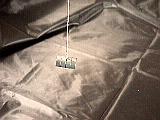
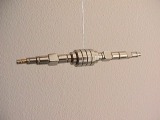
Try this out! Stick four NIB magnets together with a kite string between the middle two. (or, you can stick a bunch of small magnets together as shown in the photo on the right) Let it swing freely. It will eventually line up north to south. Label the end pointing north with a small sticker or by printing "N" onto it.

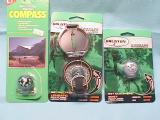
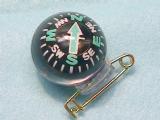
Now, take a compass. Bring it close to the NIB magnets.
Which end will the compass point to? The end opposite the "N" which is the
south magnetic pole. Pictured are a few different compasses available.
There's the ball compass, which can be pinned to your shirt or jacket. Very
handy for hiking in the woods. It is always up (like those eyeballs that stare at
you as you roll it across a table). Then there is the lensatic compass with a wire
and mirror for more precise direction determination. Today there is also GPS units
that act as compasses pointing to the true north geographic pole. There are also
electronic versions of compasses with an LCD readout, as found in cars, and
available at Radio Shack. (here's how to build
one!)
Therefore the earth's south magnetic pole is located near the geographic north pole and is called the magnetic north pole. (However, we sometimes mistakenly call it the magnetic north pole because the north pole of our magnets point to it. Confusing, isn't it? Kind of like electron current flow and conventional current flow!)
Here are great links on this topic:
http://www.eskimo.com/~billb/miscon/miscon4.html#north
Polarity of a
Magnet
Moving Poles
Did you realize that the magnetic poles of the earth is constantly moving? It moves in an oval throughout the day, and it moves along a path every year. Researchers are constantly keeping track of the magnetic poles on the earth. Check out their booklet.

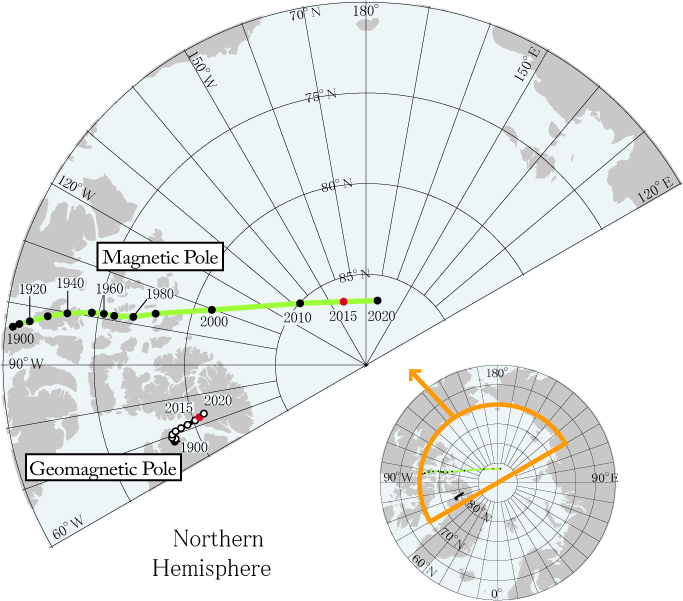

Flip-flopping Poles
Did you also realize that the magnetic field of the earth has switched several times in the past hundreds of thousands of years? This was discovered by sampling the cooled lava or magma which flows up out of the mid-Atlantic ridge and slowly pushes North America and Europe apart. When the magma cooled, it retained the magnetic field in which it was immersed (like magnetizing a magnet). Samplings of the magma showed an alternating pattern of residual magnetism. The samples taken closest to the ridge shows a magnetic field for the earth where our compass points to the north, like it does today. A little further away from the ridge shows a magnetic field opposite to the first, where our compass would point to the south! A little further still, and the magnetic field changed again, where our compass would point to the north!
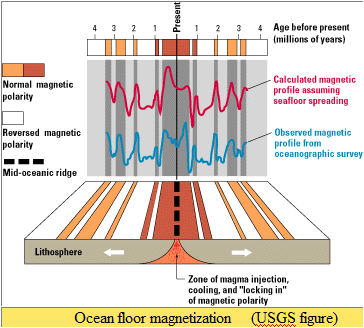
For several years, this was a real mystery! First, how does the earth create its magnetic field. How can hot, molten iron (which is basically what the earth's outer core is made of) create a magnetic field? Normally, iron by itself does not create a magnetic field. In addition, if iron did have a magnetic field, when it is very hot (when it reaches it Curie Temperature, even before it becomes molten), it would lose its magnetism because the molecules would be knocking around so hard there is no way the magnetic domains could remain lined up. Secondly, why does the magnetic field flip-flop every 100,000 to 200,000 years?
Only recently, was a reasonable model created which explained both of these mysteries. It's called the Glatzmaier-Roberts model. Very simply, there is a solid iron inner core surrounded by a hot, liquid iron outer core, that rotate slightly faster than the surface of the earth. This causes electrons to flow as a convective dynamo. This electron current creates the magnetic field. I don't have a simple way to explain why the magnetic field flips over every once in a while, but the model does faithfully show that it happens. The following web site is an excellent article by Gary Glatzmaier describing this model and the outcome of the simulation. It shows that when the magnetic field flips, it may take 2000 years for it to do so, and there may be two north magnetic poles and maybe even one, two or three south magnetic poles during the transition. It also simulates the slow drifting of the magnetic poles as we have seen in real life. We just happen to be living during a time when the poles are fairly stable, and there is only one north magnetic pole and one south magnetic pole.
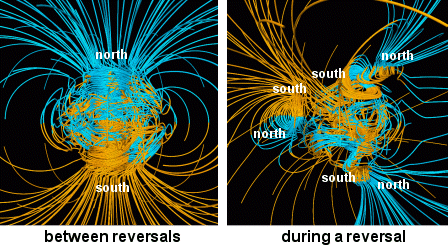
http://www.phy6.org/earthmag/dynamos2.htm
Another good resource:
Geophysics: A magnetic reversal record
Ronald T. Merrill;
Nature Volume 389 Number 6652 Page 678 - 679 (1997)
Periodically, the Earth's magnetic field reverses, and has done so hundreds of times in
the......
The funniest answer I've heard from a student on a test
about magnets is:
"Bar magnets have North and South poles, horseshoe magnets
have East and West poles."